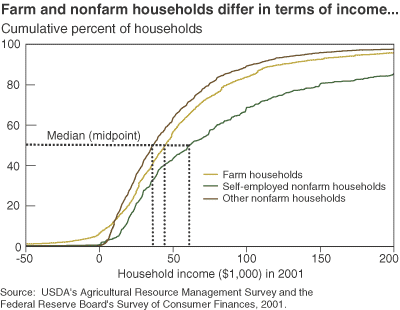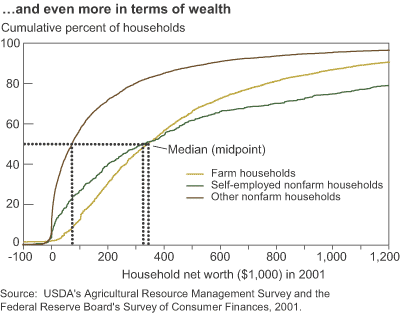Assessing Farm Household Well-Being--Beyond Farmers and Farm Income
- by Mitch Morehart and David Hopkins
- 2/1/2004
Since its inception in the 1930s, farm policy has focused on achieving economic parity between farm families and other households. Although programs supporting farmers’ incomes have been used for decades, the modern-day farm household also earns income off the farm and through investments.
A comparison of how off-farm income and wealth affect well-being of both farm and nonfarm households provides an interesting perspective on the relevance of seeking parity for today’s farmers. New data from USDA’s Agricultural Resource Management Survey and the Federal Reserve’s Survey of Consumer Finances allow comparison of America’s 2 million farm households with two separate nonfarm populations that, depending on their economic focus, have much in common with farm households: 12 million self-employed nonfarm households (those running a business other than a farm) and 94 million other nonfarm households (those who worked for someone else, were retired, or otherwise did not work) in 2001.
Arranging the households in each of the three groups from lowest to highest income and wealth and comparing the resulting distributions yields useful insights. In particular, the median of each group—where half of the households have higher income or net worth (wealth) and half have lower income or net worth—is a logical starting point for comparison. Self-employed nonfarm households had the highest median income ($62,000), followed by farm households ($45,000) and other nonfarm households ($37,000). The same ordering of incomes holds throughout the distribution—except at the lowest levels, where the order changes because farm households are more likely than nonfarm households to experience negative incomes. In 2001, negative incomes were reported for 6 percent of farm households. In contrast, far fewer nonfarm households, including self-employed households, had negative incomes.
Nonfarm households similarly lag farm households and nonfarm self-employed households when wealth distributions are compared. For example, the median net worth of farm households ($339,000) and of self-employed nonfarm households ($329,000) exceeded that of other nonfarm households ($73,400). However, the ranking of farm households and self-employed nonfarm households switched near the median. Below the median, farm households’ net worth tended to exceed that of self-employed nonfarm households. Above the median, farm households tended to have lower net worth than self-employed nonfarm households.
In effect, farm households are a diverse group. Although there are similarities to nonfarm households, any comparison is sensitive to whether income or wealth levels are used, as well as whether we compare farm households to nonfarm self-employed or the general population. As a result, the relevance and performance of farm policies that change the income and wealth distribution may be rated differently depending on the group, and the indicator, that is used for comparison purposes.
This article is drawn from:
- Farm Household Well-being. (n.d.). U.S. Department of Agriculture, Economic Research Service.



